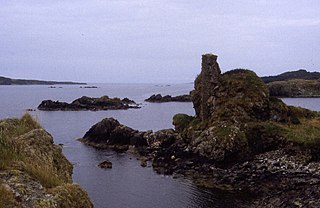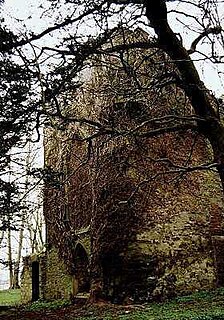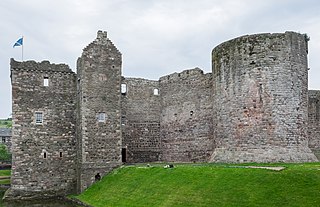 W
WAchallader Castle is a ruined 16th-century tower house under the shadow of Beinn Achaladair, about 3.5 miles north of Bridge of Orchy, Argyll and Bute, Scotland. Its name is from Gaelic, meaning field of hard water.
 W
WAchanduin Castle,, is a castle, now in ruins, located about 5.0 kilometres (3.1 mi) west of Achnacroish on the north-western coastline of the island of Lismore, in Argyll and Bute, Scotland. The castle overlooks Loch Linnhe and Bernera Island. The ruins are thought to date back to the thirteenth century. Achanduin Castle had long been thought to have been built by the Bishop of Argyll, though recent research has proved this to be unlikely. The castle was likely built by the MacDougalls around 1290 who held it throughout the fourteenth century. The castle was also thought to have been held by the Bishops of Argyll until the mid sixteenth century. It is a scheduled ancient monument.
 W
WAirds Castle is a ruined medieval castle near Carradale, Kintyre, Argyll and Bute, Scotland. The castle held a position on the summit of a rocky headland between Carradale harbour and the bay of Port Righ, looking across Kilbrannan Sound to the Isle of Arran.
 W
WAros Castle, also known as Dounarwyse Castle, is a ruined 13th-century castle near Salen on the Isle of Mull, Scotland. The castle overlooks the Sound of Mull.
 W
WAuchenbreck Castle; is located on the Cowal peninsula, in Argyll and Bute, Scotland. Its remains are situated in Kilmodan parish, near the mouth of Glendaruel, 9 kilometres (5.6 mi) north of Tighnabruaich on the Cowal peninsula. Little remains of the castle, other than a flat rectangular platform, around 35 by 18 metres, between Auchenbreck farmhouse and the Auchenbreck Burn. This is partially bounded by a revetment wall up to 2.2 metres high.
 W
WCarnasserie Castle is a ruined 16th-century tower house, noted for its unusual plan and renaissance detailing. It is located around 2 kilometres north of Kilmartin, in Argyll and Bute, western Scotland, at grid reference NM837009.
 W
WCastle Coeffin is a ruin on the island of Lismore, an island in Loch Linnhe, in Argyll, on the west coast of Scotland. It stands on a promontory on the north-west coast of the island, across Loch Linnhe from Glensanda, at grid reference NM853437.
 W
WCastle MacEwen is a ruined fort in the Cowal peninsula, on the east shore of Loch Fyne in Argyll and Bute, Scotland. It is near Kilfinan, around 5 kilometres (3.1 mi) south of Otter Ferry.
 W
WDunans Castle is an historic structure located in Glendaruel, on the Cowal peninsula, Argyll and Bute, Scotland. The property is owned by Charles and Sadie Dixon-Spain. A property at Dounens was shown on maps in 1590; Dunans House was elaborated into its present mock castle form in 1864. Once part of a much larger estate the property presently includes 16 acres (65,000 m2) of ground and in 2001 was ruined by fire.
 W
WDunaverty Castle is located at Southend at the southern end of the Kintyre peninsula in western Scotland. The site was once a fort belonging to the Clan Donald (MacDonald). Little remains of the castle, although the site is protected as a scheduled monument.
 W
WDunollie Castle is a small ruined castle located on a hill north of the town of Oban, on the west coast of Scotland in Argyll. The site enjoys views over towards the island of Kerrera and a view of the town, harbour, and outlying isles. The castle is open to the public as part of the Dunollie Museum, Castle and Grounds.
 W
WDunoon Castle is a ruined castle located at Dunoon on the Cowal peninsula in Argyll and Bute, Scotland. The castle sat upon a cone-shaped hill of about 80 feet high, a volcanic plug. Very little remains of the castle's structure today.
 W
WDunyvaig Castle, is located on the south side of Islay, in Argyll, Scotland, on the shore of Lagavulin Bay, 4 kilometres from Port Ellen. The castle was once a naval base of the Lord of the Isles, chiefs of Clan Donald. It was held by the chiefs of the Clan MacDonald of Dunnyveg.
 W
WFincharn Castle, also known as Fionchairn Castle and Glassery Castle, is a ruined castle near Ford on the southwest shore of Loch Awe, Scotland.
 W
WFinlaggan is a historic site on Eilean Mòr in Loch Finlaggan. The Loch, the island, and Finlaggan Castle lie around two kilometres to the northwest of Ballygrant on Islay.
 W
WInnes Chonnel Castle or Ardchonnel Castle is a ruined 13th-century castle on Innis Chonnell, an island on Loch Awe near Dalavich, Argyll and Bute, Scotland. It was once a stronghold of Clan Campbell.
 W
WKelspoke Castle is a ruined castle overlooking Kilchattan Bay, Isle of Bute, Scotland. Only a small amount of the ruins are above ground.
 W
WKilchurn Castle is a ruined structure on a rocky peninsula at the northeastern end of Loch Awe, in Argyll and Bute, Scotland. It was first constructed in the mid-15th century as the base of the Campbells of Glenorchy, who extended both the castle and their territory in the area over the next 150 years. After the Campbells became Earls of Breadalbane and moved to Taymouth Castle, Kilchurn fell out of use and was in ruins by 1770. It is now in the care of Historic Environment Scotland and is open to the public in summer.
 W
WKilkerran Castle is a ruined castle, near Campbeltown, Kintyre, Argyll and Bute, Scotland.
 W
WKilmahew Castle is a ruined castle located just north of Cardross, in the council area of Argyll and Bute, Scotland. The castle is close by the ruins of St. Peter's Seminary. Also close by is Kilmahew Burn. Kilmahew is named after its patron saint, Mochta (Mahew).
 W
WKilmory Castle is the remains of a 15th-century castle at Meikle Kilmory, Isle of Bute, Scotland. The castle was the residence of the Jamiesons of Kilmorie, and was already a ruin in the 18th century. The Jamiesons of Kilmorie were the hereditary coroners of Bute. The ruins are a secular listed building.
 W
W.
 W
WOld Castle Lachlan, also known as Castle Lachlan, is a ruined 15th-century castle on the shore of Loch Fyne, within the Cowal Peninsula, in Argyll and Bute, Scotland. It was probably built by Clan Maclachlan on lands first recorded in 1314 as "Castlelachlan". Nothing remains of this fourteenth-century castle. Instead, the enclosure of Old Castle Lachlan appears to date to the early fifteenth century, whilst the internal buildings seem to date to the later part of the century. The castle remained a residence of the clan's chiefs until New Castle Lachlan was built as a replacement in 1790, 0.8 kilometres (0.5 mi) east-north-east.
 W
WRothesay Castle is a ruined castle in Rothesay, the principal town on the Isle of Bute, in western Scotland. Located at NS086646, the castle has been described as "one of the most remarkable in Scotland", for its long history dating back to the beginning of the 13th century, and its unusual circular plan.
 W
WSmerby Castle, also known as Island Muller Castle, is a ruined fortified house on a promontory known as Isla Muller, Kintyre, Argyll and Bute, Scotland, north of Campbeltown. The site is protected as a scheduled monument.
 W
WTarbert Castle is located on the southern shore of East Loch Tarbert, at Tarbert, Argyll, Scotland, at the north end of Kintyre. Tarbert Castle was a strategic royal stronghold during the Middle Ages and one of three castles at Tarbert. The castle overlooks the harbour and although pre 14th century in construction, the tower dates back to 1494 and the visit of James IV to the Western Highlands.